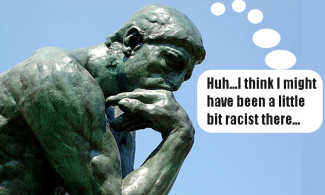1. Here’s an idea you might totally disagree with: more than anything else blaming others kills cooperation and democracy and is almost always against one’s self-interest.
Scenario
I am walking up a street. A man ahead of me carrying a bag of groceries cuts a diagonal across the street rather than crossing at the intersection. Another man driving a car turns left onto the street without seeing the first man crossing his car’s path. He hits him. I see the whole thing unfolding as in a dream, too late and too stunned to intervene. The driver gets out of the car to see what he can do to help. The victim, blood coming from his head and going down the street and his food tossed all about, starts cursing and name calling. The driver retorts with shouts defending himself.
2. Blaming is a mutually-destructive dance, a dynamic between two or more parties. “Villain” always feels the “victim” and playing “victim” can be so aggressive.
Scenario
Two sexual partners want to build a long-term relationship. Their attraction to each other is very strong and very loving, leaving them both very open and vulnerable. Almost as much as a newborn child joining its mother outside the womb. Growing up, each partner, like most of us, had suffered traumas through this openness. Unhealed scars are uncovered as our lovers open their hearts, tender and raw. Fear quickens, and one or both of them start testing for guarantees. Testing triggers more fear and insecurity, and the bird of paradise begins to feel like a hungry tiger. Blaming begins and defending rushes to the barricades.
3. Villains and victims are essential for the blame dance. If no one taking on the “villain” role, no dance. If no one taking on the “victim” role, no dance. If, however, the dance begins, to stand by is to play music for the dance. Also, blaming and punishing the dancers will never stop the blaming going on inside. It only expands and extends that reign of terror so intertwined with our loving and playing and just doing the ordinary things of life.
Scenario
A group of kids in the sandbox working together to build a fantastic sandcastle. One is a beaver of a worker and leads the delighting pack. Another is very insecure, caught very early in mostly feeling “not good enough” in most of the groups. She/he has ideas and desires, but they aren’t getting recognized because of her reticence. Not to feel so powerless she/he starts sabotaging. Still another member of the play group is attached to being a leader, and begins to assert her/himself. The beaver-leader becomes incensed and turns into a blaming villain because he/she feels victimized. The two targets are now feeling victimized. One defends as a “victim”; the other defends as a “villain” attacking with counter-blame. Most of the other kids freeze. One or two want to make things better, but these feelings are overwhelmed by lack of understanding of what to do to help.
Parents come to the rescue. Some take their frozen children away. Some reprimand their little “culprit” and order them to apologize. Or even begin spanking them for embarrassing them, the parents, in front of the other parents. Some turn and blame the parents of one of the “culprit” children, and...
Everyone leaves miserable and upset, the incident burned into their nervous systems.
4. When blaming involves big feelings and big issues it can spread like a fire in a building that stands in violation of virtually all the fire codes in the book. Members of a group, any kind of group, even groups very committed to democracy, begin taking sides and go to war. Partners become out-and-out enemies, and even enemies can become uncomfortable partners as they suddenly find themselves on the same side of the “war.”
5. There are some who can see this game when it starts happening, and know how it will play out. Sometimes they can persuade the dancers and the bystanders to shift out of the dance. Many times, when the energy becomes quite fierce, logic and words cannot work. At that point, a master of energy is needed. One who can shift the energy of the situation in such a way that “villains” lose their “victims”, “victims” end up with no “villains” to play with, and bystanders sense that some wonderful magic has happened.
Sometimes something really wondrous happens: a “villain/victim” gets it and their life begins to change.
Scenario
Harry Stack Sullivan was a psychiatrist back in the 40s and 50s. One of his patients was in a state of near total catatonia. A virtual statue. At one point Sullivan went and sat on his bed, and joined him in that catatonic state. Not passively. No, no. He sat there, wordlessly, with as much empathy as he could muster, virtually becoming as still as his catatonic patient, opening himself up to feel his feelings. Abandoning his occupation with his own reality and moving as much as he could into his patient’s field of energy.
I don’t know how long this went on. Some say it was several hours. Whatever, at one point, without moving a muscle, a tear fell from the patient’s eye down his frozen cheek.
6. Someday I might learn how to shift the energy in the middle of the blame dance. For now I struggle too much with my own attraction to the dance, and have only logic, words, and some reputation to work with. And I feel sad when those resources are too meager. Then I have the opportunity to see my feelings of wanting to blame the dancers who ran over my efforts.
7. Smile, Michael. You are on your Candid Camera.
Love to you all.


Add new comment